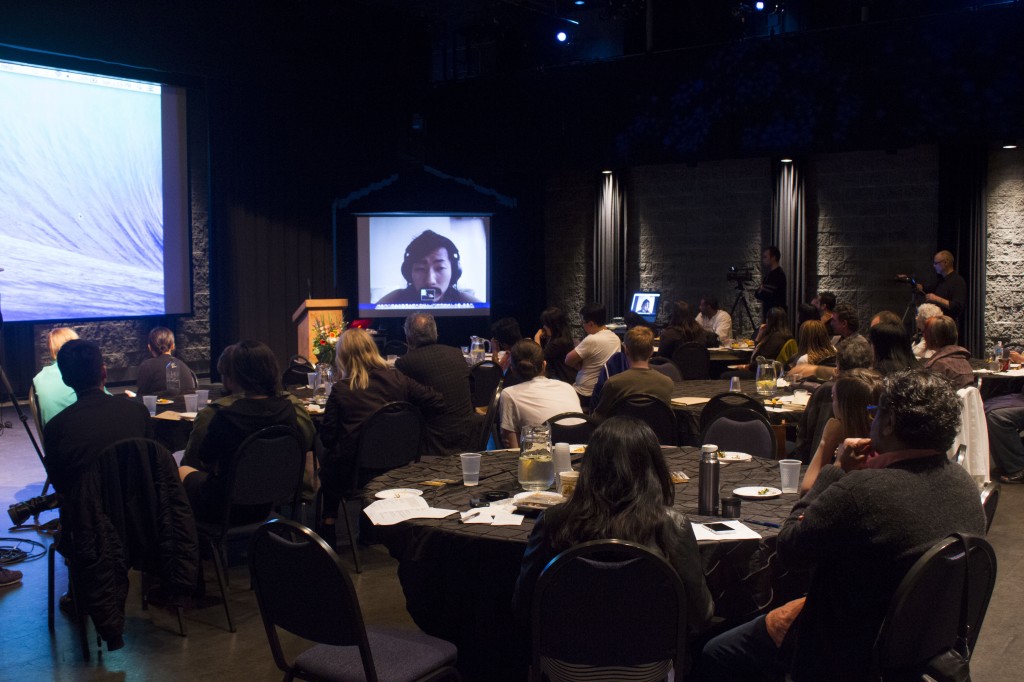PERFORMATIVITY AND EXPANDED MEDIA
Moderator: Summer Pervez
Panelists: Sammy Chien, Neelamjit Dhillon, Farrah-Marie Miranda
SUMMER PERVEZ
Music is something that I’m also intimately connected with in terms of classical music and American rock-and-roll — I liked what you said in your talk, Neelamjit, about the connections between the roots of jazz and about your own background as a Sikh activist. I’m guessing this is why you chose this particular forum, going beyond an idea that jazz just aesthetically appeals to you. Can you speak a little more to that?
NEELAMJIT DHILLON
Definitely the forms of music are linked and I think improvisation forms that connection: how do we comment on an experience? How is jazz the voice of the black experience? How can it be a voice for my own experience? And also, they just kind of happened too. As much as I’d love to say, “Yes! This was my divine vision for this music,” it was more that as a brown kid growing up in Coquitlam, it’s kind of just what happened. I went to band class and played in band and then I went home, went to the gurdwara and learned tabla; and I kept them far apart from each other for a long time. It’s only now that I’m comfortable enough and strong enough artistically to make a true intersection of these styles of music that is informed in the firm rooting of both. A lot of the times collaboration ends up being misinformed because people don’t have a strong enough background to really combine them in an informed way.
AUDIENCE 1
I was really interested in your point, Farrah, when you said how difficult it is to make whiteness strange. In my case, I came into activism because I was jaded about contemporary art. You mentioned satire as a strategy and one image I always keep in mind is this t-shirt: it has Native Americans holding guns with the slogan “Homeland Security.” It’s going back to this use of satire as a strategy, I was wondering what other strategies you have found to work in this “making whiteness strange” or perceivable?
Audience question, Panel 1, photo by Brian Giebelhaus
FARRAH-MARIE MIRANDA
I have been thinking a lot about how to deal with “the gaze” and this project tries not to speak back to whiteness, but to reverse the gaze. And that is a concept I am thinking about in some of the other work I am trying to develop. In the left we don’t laugh enough. There was a tension in organizing this project: there was a lot of incredible support for it, but there was also tension from organizing spaces and art spaces in different ways. The use of satire without having any particular political demands or goals was something that was critiqued. At the same time, I heard from the arts community that this project was too didactic, and that it’s shoving political messages down people’s throats. So, I think satire became kind of a redeeming quality in the piece because, those critiques aside, at least people could laugh. It’s a playful intervention.
AUDIENCE 2
Sammy, as a filmmaker, I was interested in your representation of how we go into a story with preconceived notions of framing what the story might be and then discovering that there are other truths to it. You talked about your experience with Taiwan, can you maybe elaborate a bit more about that process of discovery of what really went on in Taiwan? Could you give some idea of what it might mean and what you learned from the context?
SAMMY CHIEN
I also think of film as an art form that unfolds untold truth or alternative reality. Like any other form of art, it needs to continue to exist in order to bridge the gaps that the mass media and the social ideology are creating. I’ve learned more clearly that the mass media is a tool for profit-making and the profit-makers! This is why I see new media, art and technology as important vehicles for our future; they function as new portals that connect everyone to authenticity, truth, or at least alternative perspectives. There is a hacktivist group in Taiwan called g0V (kind of like Anonymous), which were the biggest tech support team for the Sunflower Social Movement, they’re doing exactly what I’m describing. Here’s a thought, if this is happening in this small island on the other side of the globe, what else is going on in the rest of the world that we may be missing and need to pay more attention to?
Panel 1 Discussion, photo by Kwantlen Polytechnic University


